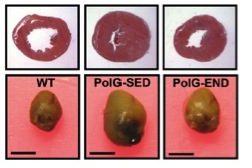Exercise vs. Aging
Almost all of the data I show in this blog comes from studies in humans or various population databases. I am going to make an exception today and show you some data about what happens when mice that are genetically modified to age early are also subjected to exercise training.
Mitochondrial Aging the Key?
One idea is that a prime driver of the aging process is a loss of mitochondrial function over time. The mitochondria are small energy factories in our cells. When they become defective the idea is that byproducts released from the mitochondria damage cells and cause aging. The picture below shows what happens when the system responsible for DNA proof reading in the mitochondria is absent in mice. The animal on left is a control while the animal on the right is aging prematurely due to the genetic alteration. The mice are called progeroid because they have features associated with a rare form of premature aging that is seen in humans called progeria.
Exercise Keep Mitochondria Healthy
Exercise keeps our mitochondria healthy as we age and it also stimulates muscle and other tissues to increase the number of mitochondria in each cell. So what happens when porgeroid mice exercise trained for 45 minutes per day three times per week for five months? The pictures below show the hearts of the mice. The panels on the left are from wild type (WT) that is genetically normal. The middle panels show an enlarged heart from porgeroid animal that was sedentary. The right panel shows that exercise training blunted the response seen in the sedentary animal.
The authors concluded that:
“Here we show that 5 months of endurance exercise induced systemic mitochondrial biogenesis, prevented mitochondrial DNA depletion and mutations, increased mitochondrial oxidative capacity and respiratory chain assembly, restored mitochondrial morphology, and blunted pathological levels of apoptosis in multiple tissues of mitochondrial DNA mutator mice. These adaptations conferred complete phenotypic protection, reduced multisystem pathology, and prevented premature mortality in these mice. The systemic mitochondrial rejuvenation through endurance exercise promises to be an effective therapeutic approach to mitigating mitochondrial dysfunction in aging and related comorbidities.”
These data and the conclusions drawn from this study clearly confirm and explain what is happening in the master athlete super agers we have discussed before.
This entry was posted on Monday, June 3rd, 2013 at 5:01 am and is filed under Current Events, Research and Health. You can follow any responses to this entry through the RSS 2.0 feed. You can leave a response, or trackback from your own site.



